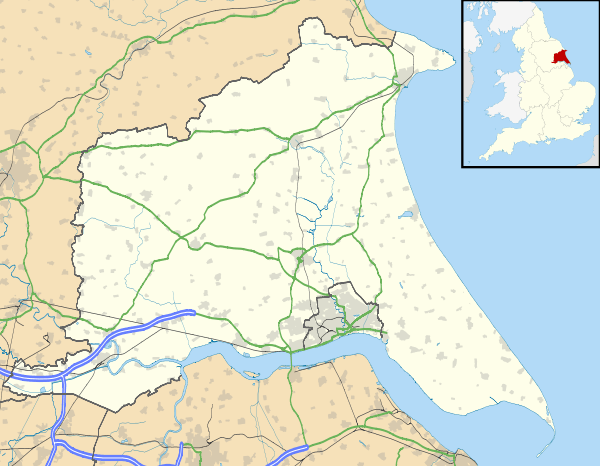Harpham
Harpham is a small village and civil parish in the East Riding of Yorkshire, England. It is located just south of the A614 road, approximately 5 miles (8 km) north-east of Driffield and 7 miles (11 km) south-west of Bridlington.
| Harpham | |
|---|---|
Mar2006.jpg) | |
 Harpham Location within the East Riding of Yorkshire | |
| Population | 303 (2011 census)[1] |
| OS grid reference | TA092617 |
| • London | 175 mi (282 km) S |
| Civil parish |
|
| Unitary authority | |
| Ceremonial county | |
| Region | |
| Country | England |
| Sovereign state | United Kingdom |
| Post town | DRIFFIELD |
| Postcode district | YO25 |
| Dialling code | 01262 |
| Police | Humberside |
| Fire | Humberside |
| Ambulance | Yorkshire |
| UK Parliament | |
The civil parish is formed by the village of Harpham and the hamlets of Lowthorpe and Ruston Parva. According to the 2011 UK census, Harpham parish had a population of 303,[1] a decline on the 2001 UK census figure of 318.[2]
Three Roman mosaics were found near Harpham in 1905, and three more were discovered in 1950. The first three are now in the Hull and East Riding Museum. They are simply patterned. One represented a rectangular maze, one of only five examples known in Roman mosaics in Britain.[3]
It is here that St John of Beverley was born in the 7th century;[4] he became the Bishop of Hexham as well as the Bishop of York. The church is dedicated to him and was designated a Grade I listed building in 1966 and is now recorded in the National Heritage List for England, maintained by Historic England.[5] The Well of St John, the local well, is named after him and is believed by many to have healing powers. The well is designated as a Grade II listed building.[6]
In 1823 Harpham was a civil parish in the Wapentake of Dickering. The St Quintin family were Lords of Harpham. The foundations of the St Quintin mansion were recorded as being to the west of the church. The church contains St Quintin burials in the north aisle and a stained glass window to Sir William St Quintin, twenty-eighth in succession, who died in 1777. Baines also notes the village as being wholly agricultural, with a population of 251. Occupations included eight farmers, two grocers, two shoemakers, a blacksmith, a wheelwright, a tailor, a butcher, and the landlord of the Anchor public house. There was also a linen manufacturer. A carrier operated between the village and Bridlington once a week.[7]
The village gave its name to HMS Harpham, a Ham class minesweeper.
References
- UK Census (2011). "Local Area Report – Harpham Parish (1170211193)". Nomis. Office for National Statistics. Retrieved 19 February 2018.
- UK Census (2001). "Local Area Report – Harpham Parish (00FB064)". Nomis. Office for National Statistics. Retrieved 27 February 2020.
- Smith, David (2005). Roman Mosaics at Hull. p. 42. ISBN 0904490 34 3.
- Walsh, Michael J. (2007). A New Dictionary of Saints: East and West. London: Burns & Oats. p. 316. ISBN 0-86012-438-X.
- Historic England. "Church of Saint John of Beverley (1083345)". National Heritage List for England. Retrieved 12 August 2013.
- Historic England. "Saint John's Well (1083346)". National Heritage List for England. Retrieved 21 October 2013.
- Baines, Edward (1823). History, Directory and Gazetteer of the County of York. pp. 212, 213.
- Gazetteer – A–Z of Towns Villages and Hamlets. East Riding of Yorkshire Council. 2006. p. 6.
External links

- Harpham in the Domesday Book